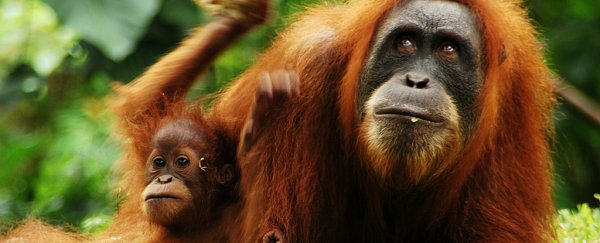Bornean orangutans, the largest tree-dwellers on the planet, are vanishing. The population of these great apes was halved between 1999 and 2015, per an estimate published Thursday in the journal Current Biology.
A survey of orangutan nests, coupled with a statistical analysis of habitat changes, indicates that more than 100,000 animals were lost in the last 16 years.
It is a dramatic drop for the animals who, because their genomes and unique physical characteristics so resemble ours, are among the closest living relatives to humans.
Orangutans' exact numbers are uncertain. They are intelligent and shy and prefer thick forests.
You could walk by an orangutan hiding in the canopy and never know the 4-foot-tall (1.2 metre tall) animal was there, said Maria Voigt, an expert in sustainability and ape habitat at the Max Planck Institute for Evolutionary Anthropology in Germany.
Counting the shaggy orange creatures by sight would be a very difficult task.
Instead, surveyors tally orangutan nests. Orangutans, before they sleep, bend long branches into structures that look like leafy baskets. The nests are so large that researchers can use helicopters to spot them.
Since 1999, surveyors have covered a total of 500 square miles in Borneo looking for their nests.
One nest does not equal one ape. Some orangutans, especially infants and mothers, may crowd together into the same nest. Researchers must also account for abandoned nests, too. But extrapolating population counts from the nests is possible.
When the study began, surveyors found 22 nests per every kilometer traveled. By 2015, they found 10 nests in the same distance.
Voigt and her co-authors, an international team of ecologists, biodiversity experts, conservationists and others, created a mathematical model to track the ape population.
They bundled the decreasing number of nests together with human population density, deforestation and rates at which orangutans are hunted and killed.
By the researchers' best estimate, there were 148,500 more orangutans in 1999 than in 2015. Some experts were shocked to see such a precipitous decline. Others doubted that there were so many orangutans in 1999.
Voigt summarised their responses: "That can't be, that's too much, we don't think there are so many left."
But the findings are on par with other declines in great ape populations, she said. Grauer's gorilla populations have dropped by 80 percent in 20 years. The western chimpanzee population dropped by 80 percent in 25 years.
The researchers estimate there are 17,000 to 100,000 Bornean orangutans left, Voigt said. Looking to 2050, a business-as-usual model suggested a less dramatic decline - a loss of 45,300 animals from habitat destruction.
Demand for wood, palm oil and other natural resources harvested in Borneo has fractured the island's forests. Plantations replaced orangutan habitats in some areas.
But those plantations can become "steppingstones," Voigt said, that enable the apes to travel between fragmented forests.
The new research suggests that in places where valuable trees are selectively logged but the rest of the forest remains intact, orangutans will return. "If the fruit trees are left intact, then the disturbance is minimal," Voigt said.
What had been widely underestimated, Voigt said, was the number of orangutans hunted for meat or otherwise killed by humans. Voigt said she suspected conservationists might have been reluctant to point to humans for the population decline.
"People have hunted orangutans since they coexisted," Voigt said. But there is nuance amid the conflict - even the word "conflict," she said, suggests the involvement of two equal partners, which is not the case when one party has a gun.
Bornean hunters target orangutans only as a last resort, she said, and prefer pigs and deer. Others might kill orangutans out of surprise, if "an orangutan and human meet and the human gets scared," she said.
Interviews with people who live near orangutans suggest orangutan deaths per village are low. Perhaps a village will report that one orangutan was killed in the past few years, Voigt said.
But multiplied over many villages in forest area, and the deaths add up: As little as one orangutan killed out of 100 each year can cause the species to decline. Orangutans are slow to reproduce, having at most a newborn every six years.
But there is hope for this species, Voigt said. Humans can be taught to live in peace with orangutans. "We have relatively stable populations in national parks. We see that they can coexist with humans," she said.
"If we stop the killing they could even bound back."
2017 © The Washington Post
This article was originally published by The Washington Post.
